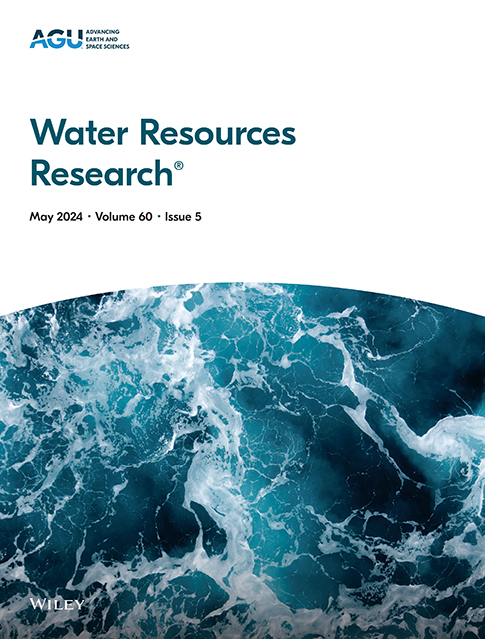Isogeochemical Characterization of Mountain System Recharge Processes in the Sierra Nevada, California
IF 4.6
1区 地球科学
Q2 ENVIRONMENTAL SCIENCES
引用次数: 0
Abstract
Mountain System Recharge processes are significant natural recharge pathways in many arid and semi-arid mountainous regions. However, Mountain System Recharge processes are often poorly understood and characterized in hydrologic models. Mountains are the primary water supply source to valley aquifers via lateral groundwater flow from the mountain block (Mountain Block Recharge) and focused recharge from mountain streams contributing to focused Mountain Front Recharge at the piedmont zone. Here, we present a multi-tool isogeochemical approach to characterize mountain flow paths and Mountain System Recharge in the northern Tulare Basin, California. We used groundwater chemistry data to delineate hydrochemical facies and explain the chemical evolution of groundwater from the Sierra Nevada to the Central Valley aquifer. Stable isotopes and radiogenic groundwater tracers validated Mountain System Recharge processes by differentiating focused from diffuse recharge, and estimating apparent groundwater age, respectively. Novel application of End-Member Mixing Analysis using conservative chemical components revealed three Mountain System Recharge end-members: (a) evaporated Ca-HCO3 water type associated with focused Mountain Front Recharge, (b) non-evaporated Ca-HCO3 and Na-HCO3 water types with short residence times associated with shallow Mountain Block Recharge, and (c) Na-HCO3 groundwater type with long residence time associated with deep Mountain Block Recharge. We quantified the contribution of each Mountain System Recharge process to the valley aquifer by calculating mixing ratios. Our results show that deep Mountain Block Recharge is a significant recharge component, representing 31%–53% of the valley groundwater. Greater hydraulic connectivity between the Sierra Nevada and Central Valley has significant implications for parameterizing groundwater flow models. Our framework is useful for understanding Mountain System Recharge processes in other snow-dominated mountain watersheds.加利福尼亚内华达山脉山系补给过程的等地球化学特征
在许多干旱和半干旱山区,山系补给过程是重要的天然补给途径。然而,水文模型对山系补给过程的理解和描述往往不够充分。山区是河谷含水层的主要水源补给来源,通过来自山区块的横向地下水流(山区块补给)和来自山区溪流的集中补给,在山麓地带形成集中的山前补给。在此,我们介绍了一种多工具等地球化学方法,用于描述加利福尼亚州图莱尔盆地北部的山地流路径和山地系统补给。我们利用地下水化学数据来划分水化学面,并解释从内华达山脉到中央山谷含水层的地下水化学演变过程。稳定同位素和放射性地下水示踪剂分别通过区分集中补给和扩散补给以及估算地下水表观年龄,验证了山系补给过程。使用保守化学成分的末端成员混合分析法的新应用揭示了山系补给的三种末端成员:(a) 与集中山前补给相关的蒸发 Ca-HCO3 水类型,(b) 与浅山区块补给相关的停留时间较短的非蒸发 Ca-HCO3 和 Na-HCO3 水类型,以及 (c) 与深山区块补给相关的停留时间较长的 Na-HCO3 地下水类型。我们通过计算混合比,量化了每个山系补给过程对河谷含水层的贡献。结果表明,深山区块补给是一个重要的补给组成部分,占山谷地下水的 31% 至 53%。内华达山脉与中央河谷之间更大的水力连通性对地下水流模型的参数化具有重要影响。我们的框架有助于了解其他以雪为主的高山流域的山系补给过程。
本文章由计算机程序翻译,如有差异,请以英文原文为准。
求助全文
约1分钟内获得全文
求助全文
来源期刊

Water Resources Research
环境科学-湖沼学
CiteScore
8.80
自引率
13.00%
发文量
599
审稿时长
3.5 months
期刊介绍:
Water Resources Research (WRR) is an interdisciplinary journal that focuses on hydrology and water resources. It publishes original research in the natural and social sciences of water. It emphasizes the role of water in the Earth system, including physical, chemical, biological, and ecological processes in water resources research and management, including social, policy, and public health implications. It encompasses observational, experimental, theoretical, analytical, numerical, and data-driven approaches that advance the science of water and its management. Submissions are evaluated for their novelty, accuracy, significance, and broader implications of the findings.
文献相关原料
| 公司名称 | 产品信息 | 采购帮参考价格 |
|---|
 求助内容:
求助内容: 应助结果提醒方式:
应助结果提醒方式:


